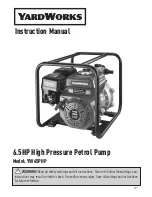
4
4.1) Shut off the municipal water supply and plumb ¾" tubing/piping into the municipal water supply line. This must be branched
off of a ¾" line and plumbed with ¾" tubing/piping to the Home Guard
®
Max . Do not use garden hose or other flexible hose/
tubing. Install a shut off valve in the ¾" supply line to the Home Guard
®
Max. Use the appropriate back-flow prevention for
your jurisdiction. Supply piping shall be made of materials and methods approved by the local plumbing codes.
4.2) Do not braze/solder copper fittings within 18” of Home Guard
®
Max, as the heat from the torch will damage the pump body.
4.3) When assembling threaded fittings into the Home Guard
®
Max inlet, do not use pipe dope on the inlet threads, use PTFE
(Teflon
®
) sealing tape. Take special care to keep any debris (including pieces of tape) from entering the inlet fitting that might
get caught in the operating valve.
4.4) The Home Guard
®
Max includes a field installed Push-to-Connect fitting. This fitting is designed to be used with ¾” PEX,
CPVC, or copper pipe. The fitting must be installed on the ¾" NPT thread of the pump inlet fitting.
Caution must be used
when installing the fitting to not over tighten the inlet fitting and crack the body. Using a backup wrench, hold the
inlet fitting while tightening the Push-to-Connect fitting.
If the Push-to-Connect fitting is not used, the same precaution
must be used when installing any other fitting to the inlet fitting. A union or quick-disconnect fitting should be installed to
make the pump accessible for servicing.
4.5) Purge the water line prior to connecting to the Home Guard
®
Max to ensure that debris does not enter the unit and clog the
operating valve. Install a dedicated shut-off valve on the water supply line within 6 ft. (1.8 m) of the Home Guard
®
Max.
4.6) If using the Push-to-Connect fitting, cut the tube so that the ends are square. Ensure that there are no burrs or damage to
the cut end. Once the tubing end is cut square and clean, scribe a depth mark on the outside of the tubing 1” from the end.
Insert the tube through the release collar to rest against the grab ring. Push the tube firmly with a slight twisting action until
it reaches the tube stop. The depth mark should be up to the end of the release collar. The tube liner is not necessary with
CPVC or Copper tubing, and may be removed based on preference or local codes. The tube liner can be easily removed by
pulling it out with a needle nosed pliers.
4.7) Once the pump has been installed and the municipal water source connected, slowly open the municipal water source valve
and the supply line valve. Inspect the valve body and all connections looking for leaks. Close the municipal water valve and
fix any leaks before operating the pump.
STEP 5: Testing of Pump Operation
5.1) Unplug the primary pump so that it does not start.
5.2) Fill the sump with water until the Home Guard
®
Max starts. NOTE: The sump must be full of water for the pump to shut off properly.
5.3) Verify that the pump starts and stops at the desired ON/OFF points.
5.4) Verify that there are no leaks in the discharge line.
5.5) If adjustment is necessary, raise or lower the stops according to STEP 2.
5.6) If the pump is not operating properly after following the above steps, refer to the Troubleshooting guide.
5.7) When finished testing, plug primary pump back into AC receptacle.
5.8) Adjust alarm reed switch (optional) to desired level, if necessary. Refer to FM2571 for Alarm System Instructions. Be sure
to install 9V battery in Alarm Panel.
WATER PRESSURE:
20 PSI minimum with valve open.
80 PSI maximum with valve open.
100 PSI maximum with valve closed.
EFFICIENCY:
The pumping capacity increases with household water pressure and flow.
At an eight-foot static head and a supply pressure of 20 PSI at water supply inlet with water flowing, it takes one (1) gallon of
supply water to remove one gallon from the sump. As the supply pressure increases with the static head constant, less supply
water is required.
INSTALLATION,
continued
© Copyright 2015 Zoeller
®
Co. All rights reserved.
STEP 4:
continued





































